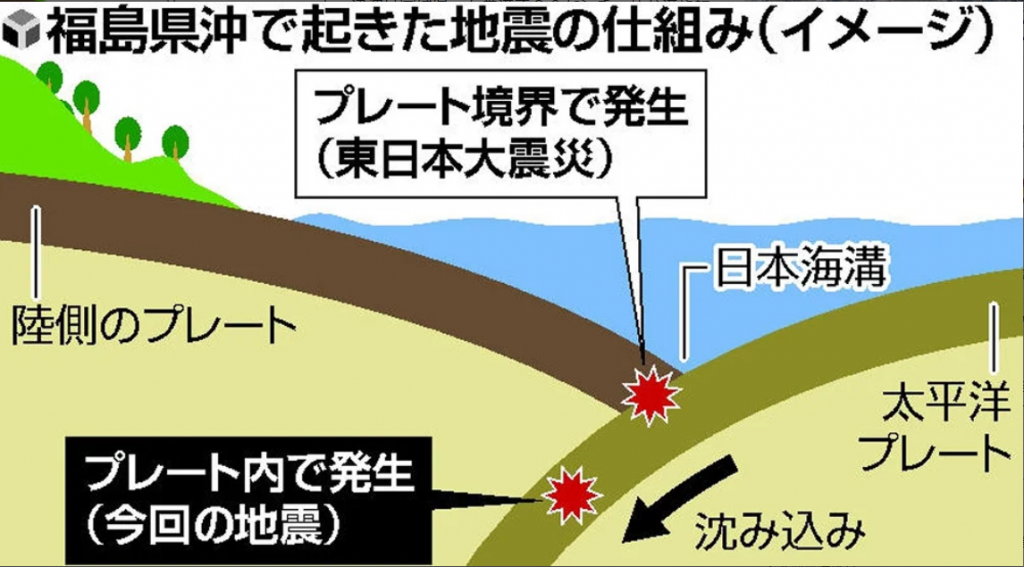There was not a major tsunami, but if the epicenter was a little shallower … “This time it was very close.” -Chairman of the investigation committee

福島県沖を震源に最大震度6強を観測した13日夜の地震について、政府の地震調査委員会は14日、臨時会を開き、陸側の岩板(プレート)の下に沈み込んだ海側の「太平洋プレート」内部で起きたと発表した。震源が約55キロ・メートルと比較的深く、海底が大きく変形しなかったため、被害を伴う大きな津波は発生しなかった。
In response to the earthquake on the night of the 13th, which recorded a maximum seismic intensity of a little over 6 off the coast of Fukushima Prefecture, the government’s Earthquake Research Committee held an extraordinary session on the 14th, and announced that the seaside that sank under the rock plate occurred within the “Pacific Plate”. The epicenter was relatively deep, at about 55 km, but the seafloor did not deform significantly, so there was no major tsunami that could have caused damage.
震源は、東日本大震災の震源の南西約110キロ・メートルで、震災の余震域にあたる。同委員会によると、津波は宮城県・石巻港で20センチ、仙台港や福島県相馬市などで10センチを観測。今回の地震後、余震が54回発生し、うち3回は震度3以上だった(15日午前10時現在)。
The epicenter was about 110 kilometers southwest of the epicenter of the Great East Japan Earthquake, which is in the aftershock area of that earthquake. According to the committee, a 20cm tsunami was detected at Ishinomaki Port in Miyagi Prefecture and a 10cm tsunami at the Sendai Port of Soma City in Fukushima Prefecture among other places. After the earthquake, there have been 54 aftershocks so far, with 3 of them having a seismic intensity of 3 or higher (as of 10:00 am on the 15th).
気象庁は、地震発生から約1週間、最大震度6強程度の地震に注意するよう呼びかけている。同委員会の平田直なおし委員長(東京大名誉教授)は、「もう少し震源が浅く規模が大きければ、高い津波が発生した可能性がある。今回はぎりぎりだった。津波は30センチの浸水でも大人が足を取られてしまう。沿岸に住む方は改めて津波に注意してほしい」と強調した。
The Japan Meteorological Agency warns that further earthquakes with a maximum seismic intensity of 6 or higher may occur in its wake for the next week. “If the epicenter was a little shallower and larger, a high tsunami could have occurred. This time it was very close. Even a 30cm flood by a tsunami can sweep adults off their feet. I want those who live along the coast to be aware of a potential tsunami next time.” emphasized Naoshi Hirata, chairman of the committee (Professor Emeritus of the University of Tokyo)
今回の地震では、激しい揺れが広い範囲で観測された。東北大の日野亮太教授(地震学)によると、このタイプの地震は、震源が深いため津波を伴いにくい一方、浅い地震に比べて揺れが広い範囲に及びやすいという。人が感じやすい「ガタガタ」とした小刻みな揺れが生じるのも特徴といい、日野教授は「今回の地震は震源が陸に近かったこともあり、震度が大きくなった」と話している。
In this most recent earthquake, violent shaking was felt over a wide area. According to Professor Ryota Hino (Seismology) of Tohoku University, this type of earthquake is less likely to be accompanied by a tsunami due to its deep epicenter, but it is more likely to tremor over a wider area than a shallow earthquake. It’s characterized by rattling with brief and repetitive shaking that is easy for people to feel. “The epicenter of this earthquake was close to the land, so the seismic intensity increased.” says Professor Hino
SOURCE: https://www.yomiuri.co.jp/science/20210215-OYT1T50012/
[One of my recently translated articles (for practice)]

